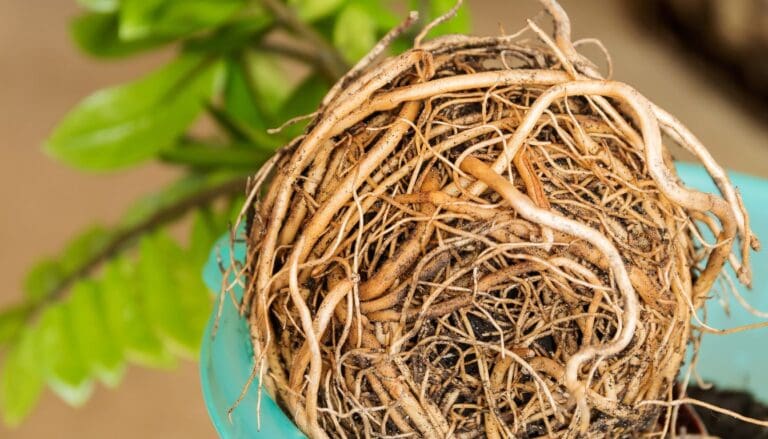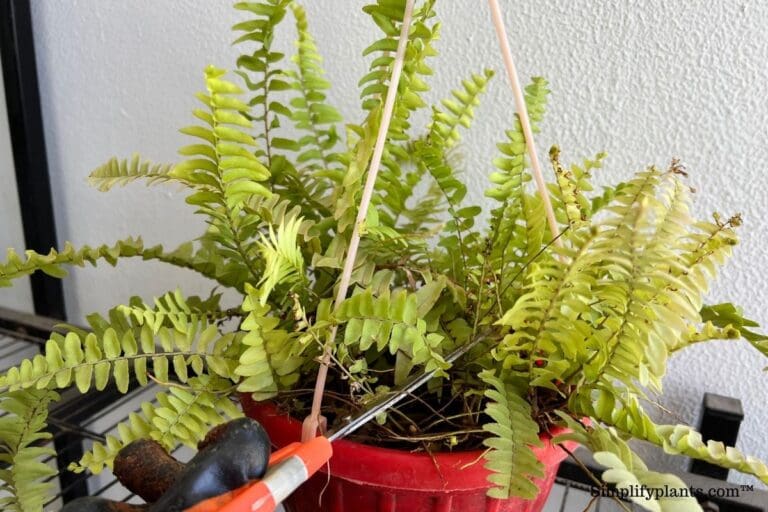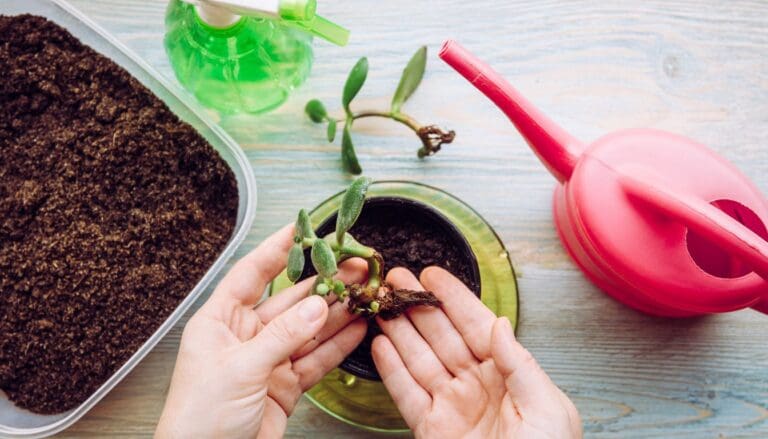Do Money Trees Like To Be Root Bound? (+When To Repot)
Curious about root-bound money trees? Does a money tree like to be root-bound? Let’s find out.
Money trees can survive being root bound, but it isn’t ideal for money trees. When roots outgrow their space, it limits growth, causes droopy leaves, and restricts nutrient and oxygen supply. Typically, money trees need repotting every few years to thrive. You can also trim the roots every 2-3 years to keep them in the same pot.
The root system of the money tree is smaller than that of many other plants, so it doesn’t get root-bound very fast.
We have covered all the details regarding a root-bound money tree. Let’s understand how to identify a root-bound plant and the next steps you need to take.

Please note: Simplify Plants is reader-supported. As an Amazon Associate, I earn from qualifying purchases made by our readers with no extra cost added to you all! Some links in the post are affiliate links and I get a commission from purchases made through links in the post.
Do money trees like to be in small pots?
The money trees don’t like to be in small pots because it restricts their growth. However, money trees have a smaller root system, so they don’t need a large pot like many other indoor plants.
A root-bound plant is usually planted in a small container, and its roots don’t have enough space for growth. The roots even fail to perform their regular functions, weakening the plant and causing stunted growth.
As the plant grows, its roots will also develop and expand. For this, space is required in the pot. When the roots don’t have enough room for growth, they become tangled and displace all the soil from the pot.
If the roots remain constrained for a prolonged period, they will form clusters and become brown. This will cause root rot.
The plant doesn’t get enough nutrition or water when the soil starts getting displaced. The pot fails to hold the nutrition as it passes along with water to the drainage system. This leads to dehydration in the plant.
You can cure this by repotting the plant to a larger pot. If you don’t do this, your plant will not survive due to a lack of nutrients.
If you can identify the early signs, you can save your plant before any disaster occurs.
Also read: What happens if you put a plant in too big of a pot?
How do I know if my money tree is root-bound?
It might be challenging to understand if your money tree is root-bound. However, we can help you to figure it out.
First, you need to check your plant closely to determine if it is giving out any signs. Noticing the symptoms during the early stages can help you fix your plant on time.
Second, if you notice any sign and doubt the plant is root-bound, you must take it out of its container and examine the roots. You have a root-bound plant if you see a cluster of roots.

The signs that will tell you if your money tree is root-bound or not are:
- The roots will come out of the drainage holes.
- The pot might start cracking due to the pressure of the roots.
- The growth of the plant might slow down or stop.
- The roots will begin displacing the soil.
- There will be a decrease in the amount of soil in the pot.
- Leaves may turn brown.
- The leaves will start drooping and curling.
- The plant will become dry due to a lack of water and nutrition.
Now, let’s understand the different stages of a root-bound plant. This knowledge will help you take action depending on your plant’s stage.
In the first stage, the roots begin to wrap around one another. When your plant is at this stage, you can fix it easily. But if you keep ignoring it, the issue might get worse. However, you can even take a year to shift your plant to a bigger pot at this stage.
In the second stage, the roots form mats around the root ball. It can get more complicated than the first stage, but you can still fix it by shifting the plant to the larger pot at the right time.
In the third stage, the roots start displacing the soil and form clusters. If you don’t give immediate attention and delay repotting the plant, you might be unable to save it.
How do you know when to repot a money tree?
Although a money tree grows up to 60 feet in its native land, it will grow 6 to 8 feet long inside the house.
The growth rate of the money tree can range from slow to medium, and it does not grow very fast. The root system of the money tree is smaller than many other plants, so it can take time for the money tree to get root-bound.
However, repotting the money tree every 2 to 3 years is best.
Even if your plant is not root-bound, repotting every two or three years helps the plant gain all the lost nutrients as the soil loses nutrition and becomes acidic over time.
Summer and spring seasons are ideal for repotting your money tree. You should avoid repotting during winter as that is the dormant period for the plant. Repotting during winter can cause stress to your money tree.
Also Read: How To Take Care Of A Money Tree In The Winter?
Best soil and pot for money tree

Keeping your money tree in a too small pot will make it root-bound. However, keeping it in a larger pot will retain excess water and cause root rot.
If you use a small pot for your money tree, you will face issues such as:
Stress – You will notice that your money tree is stressed if it’s living in a small pot. The money tree will feel constricted in a small pot, due to which it will suffer from stress.
Soil reduction – You will notice that the amount of soil has reduced if you remove the plant from the pot. This happens because the roots don’t have enough space to grow, so they displace the soil to make space for themselves. Soil reduction can lead to various problems, such as lack of nutrition.
Dehydration – Due to reduced soil, the remaining soil will not hold the required water. This will make the money tree dehydrated. The plant will have curled leaves, which is a sign of dehydration.
In case the pot is too large for your money tree, the problem can be:
Overwatering – You might not be overwatering your plant. But keeping it in a large pot is as good as overwatering it. A large pot holds too much water and keeps the roots wet for long.
Root rot – When the pot retains too much water, the roots will remain wet for an extended period and be prone to root rot. It is a serious problem in plants and can cause severe damage.
Pest infestation – A large pot creates an environment similar to overwatering. This is ideal for pests and can also cause fungal or bacterial infections.
Whenever choosing a pot for repotting your money tree, you need to go one size up from the previous pot. The pot should be at least 2″ larger than the plant’s size.
Along with the size of the pot, you need to take care of the drainage system. You can choose a pot with drainage holes or make the drainage holes yourself before placing the plant in it.
In the case of the material, it’s better to use clay, ceramic, and terracotta pots instead of plastic ones. This will allow good airflow inside the soil and roots.
Let’s talk about which soil is best for your money tree.
The money tree does not enjoy sitting in the water for a prolonged period. Therefore, it requires soil that supports well drainage.
After you water the money tree, the soil should retain the required amount of water and drain the excess water out of the pot.
You can choose a sand-based soil to remove excess water from a system. You can purchase any succulent or cactus mix available in the market and add peat and perlite to make it well-draining.
How to save a root-bound money tree?
You can fix a root-bound money tree by:
- Repotting the plant
- Pruning the extra roots
Let’s take a look at these methods.
Repotting money tree

You can repot your money tree during the growing season, which is summer and spring. You need the correct-sized container and well-draining soil before proceeding with this.
After taking the money tree out of its pot, you need to get rid of the damaged roots and prune all the damaged leaves or stems of the plant.
Add the fresh soil mix to the pot and place the money tree at the center. Add soil from all sides of the container to help the plants settle in.
Pruning the extra roots
You can fix a root-bound plant without having to repot it. You can do it by pruning the roots that have formed a cluster but avoid damaging the primary roots.
You can also prune the roots so that it has become unhealthy.
Once you trim the old roots, the plant will have more space and energy for new growth. Besides focusing its energy on recovering the damaged roots, it will concentrate on new development.
Final words
You should not let the money tree remain root-bound for too long, as it can lead to stunted growth in your plant. It can also cause other problems that we have discussed in the article.
Therefore, you should always check your plant every two to three years and consider repotting it whenever required.
Repotting the money tree will keep it healthy and allow new and healthy growth in the plant.
If you notice any signs telling you you have a root-bound plant, repot it to avoid problematic situations.
Reference: WIKIPEDIA.
Recommended Garden Supplies
| Product Image | Our Recommended Gardening Supplies | Check Offers! |
|---|---|---|
Top Top
Top
Top
Top
Top
Top
Top
Top | rePotme Houseplant and Tropical Classic Potting Soil Mix | Check Offer On Amazon |
 Top
Top
Top
Top
Top
Top
Top
Top | Espoma Organic Indoor Plant Food | Check Offer On Amazon |
 Top
Top
Top
Top
Top
Top
Top
Top | GooingTop LED Grow Light 6000K Full Spectrum Clip Plant Growing Lamp | Check Offer On Amazon |
 Top
Top
Top
Top
Top
Top
Top
Top | Soil Moisture Meter | Check Offer On Amazon |
 Top
Top
Top
Top
Top
Top
Top
Top | Govee Hygrometer Thermometer, Bluetooth Enabled! | Check Offer On Amazon |
 Top
Top | LEVOIT Humidifiers for Large Room(Best For Plants) | Check Offer On Amazon |
 Top
Top
Top
Top
Top
Top
Top
Top | Upgraded DIY Automatic Drip Irrigation Kit, 15 Potted Houseplants Support | Check Offer On Amazon |
 Top
Top
Top
Top
Top
Top
Top
Top | Stainless Steel Heavy Duty Gardening Tool Set | Check Offer On Amazon |
 Top
Top
Top
Top
Top
Top
Top
Top | Bonide Insecticidal Soap | Check Offer On Amazon |
 Top
Top
Top
Top
Top
Top
Top
Top | Bonide 32 oz Spray Neem Oil for Organic Gardening | Check Offer On Amazon |
 Top
Top
Top
Top
Top
Top
Top
Top | Garden Safe Fungicide | Check Offer On Amazon |






